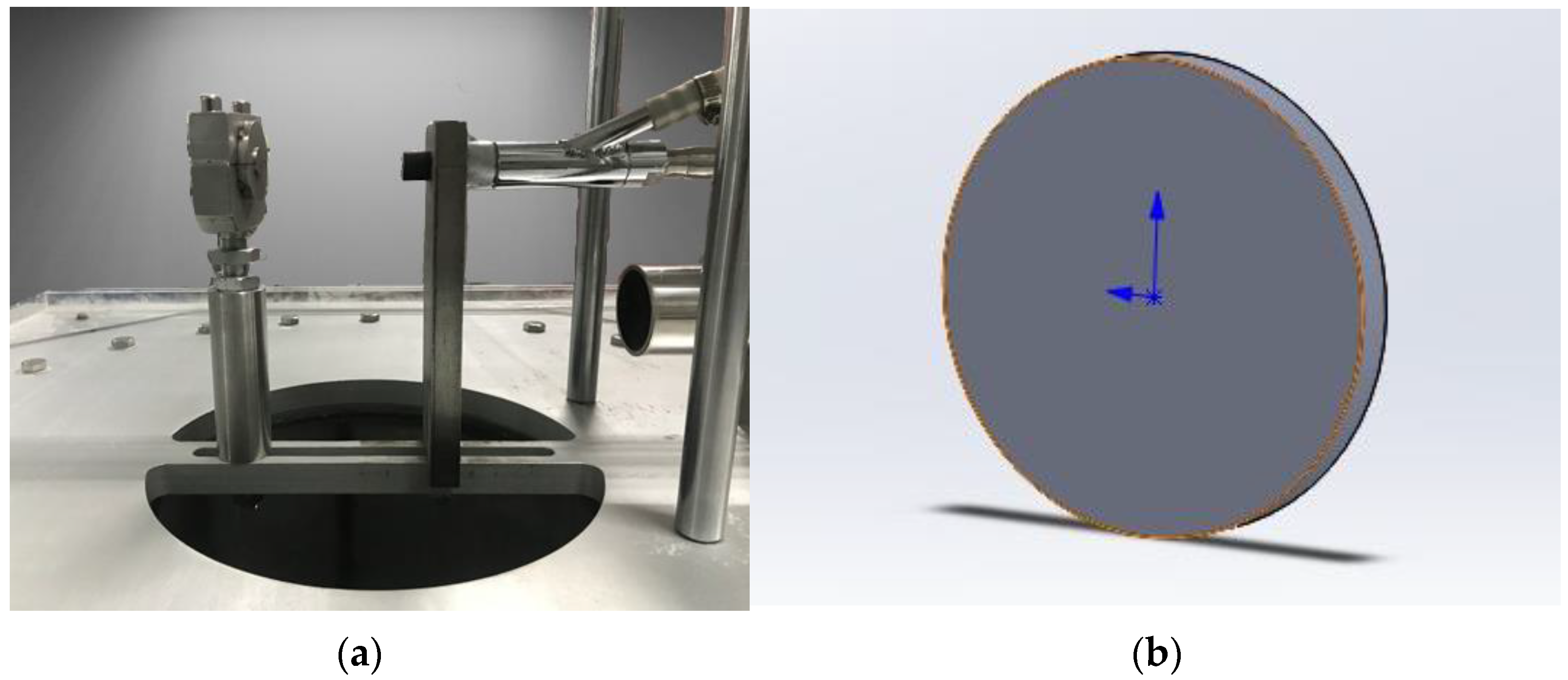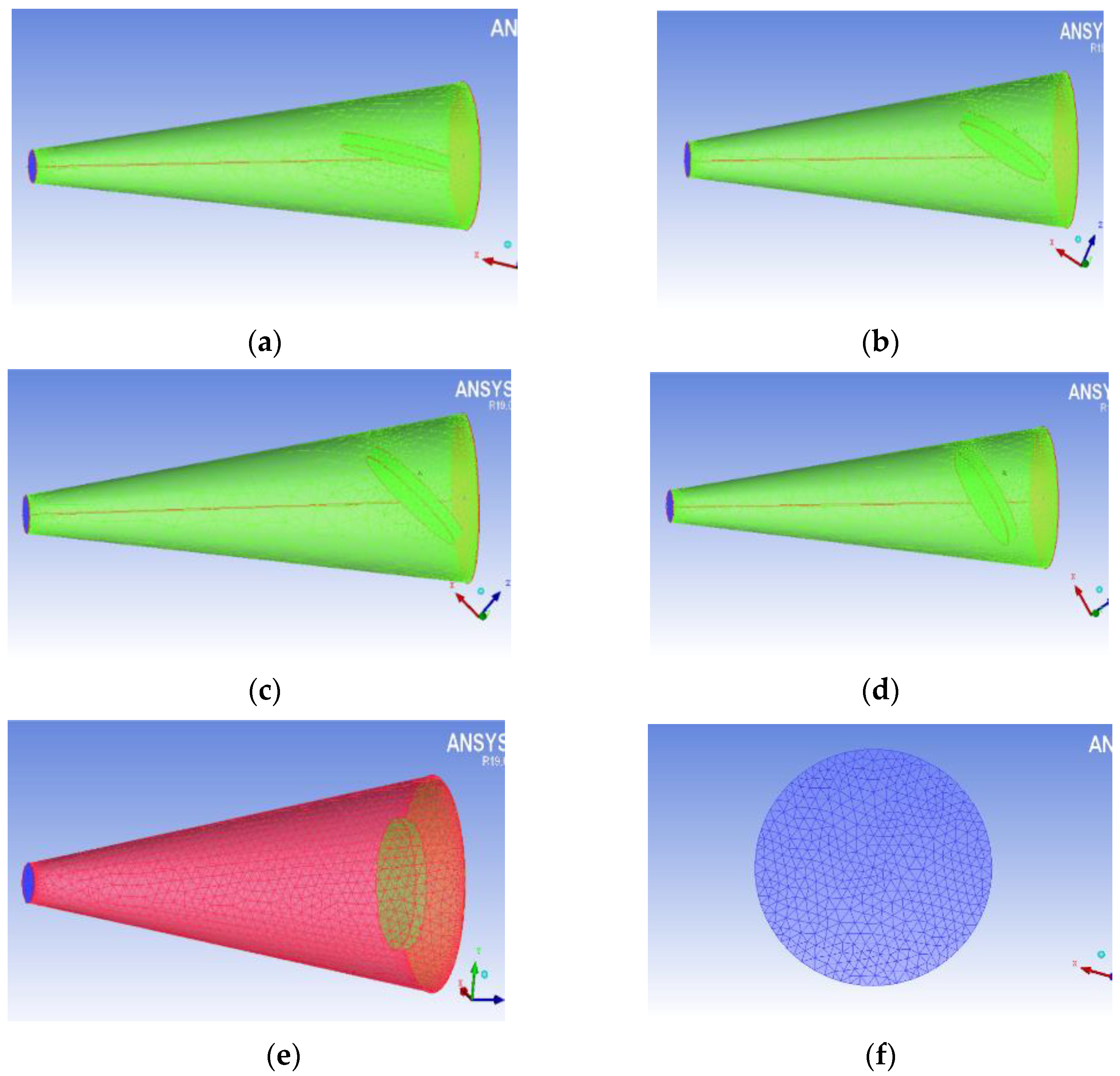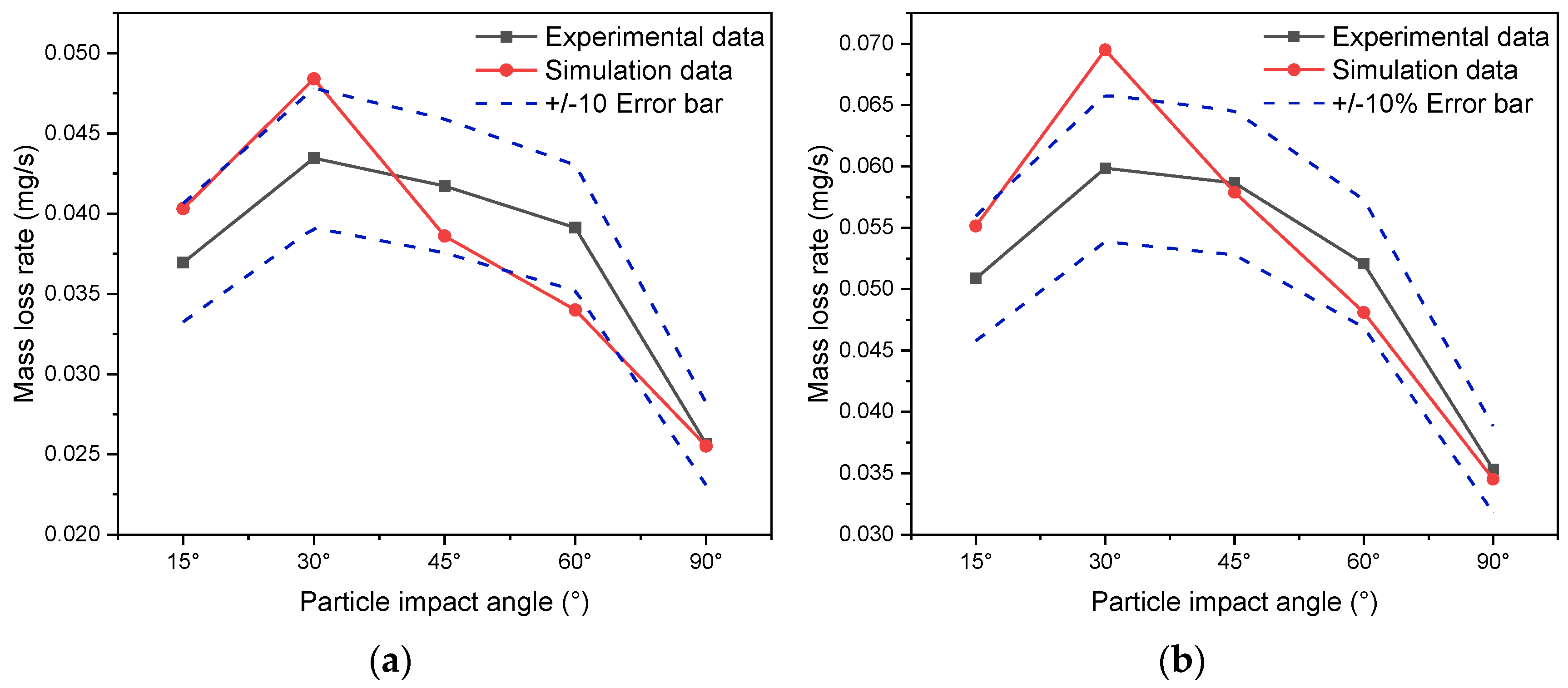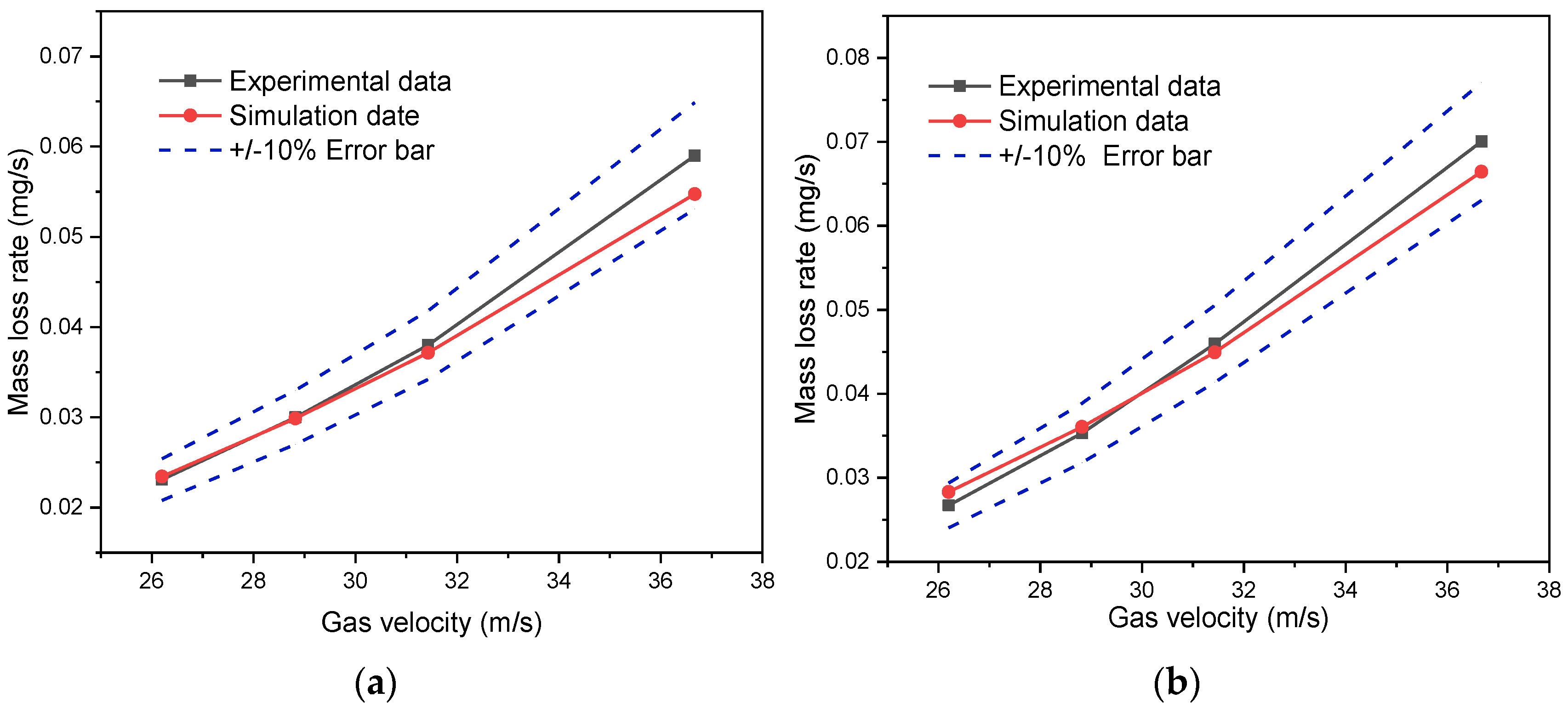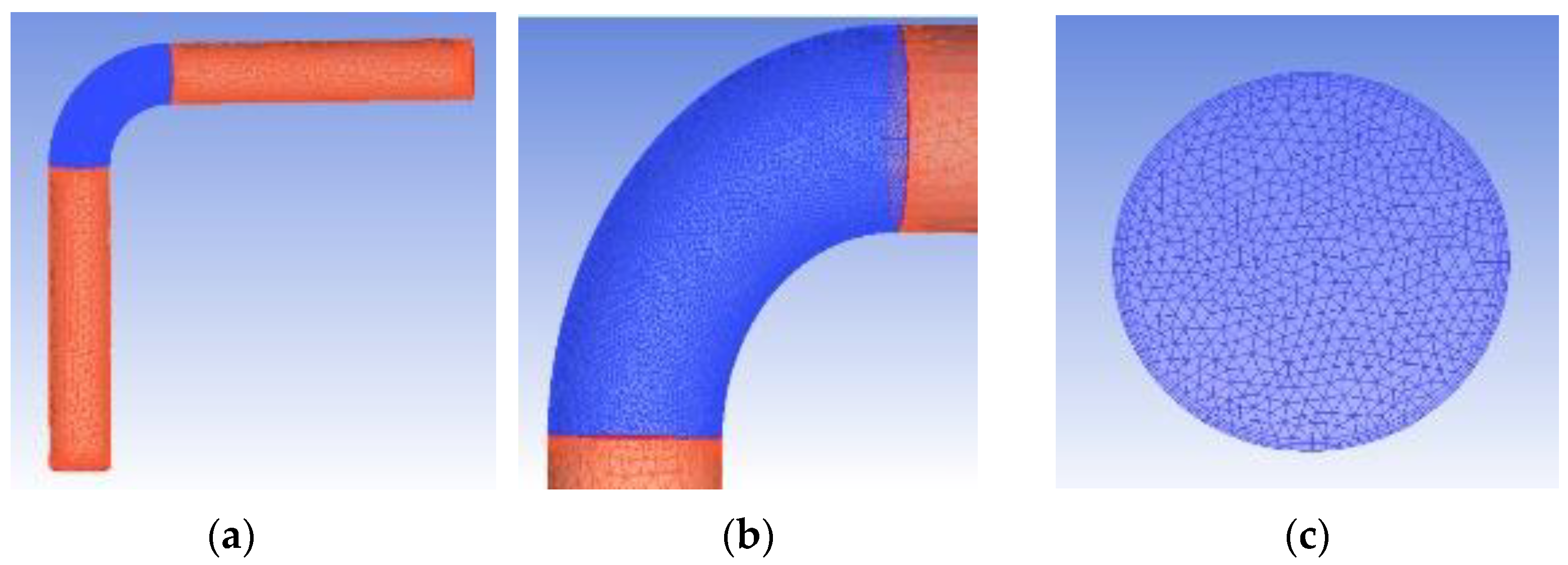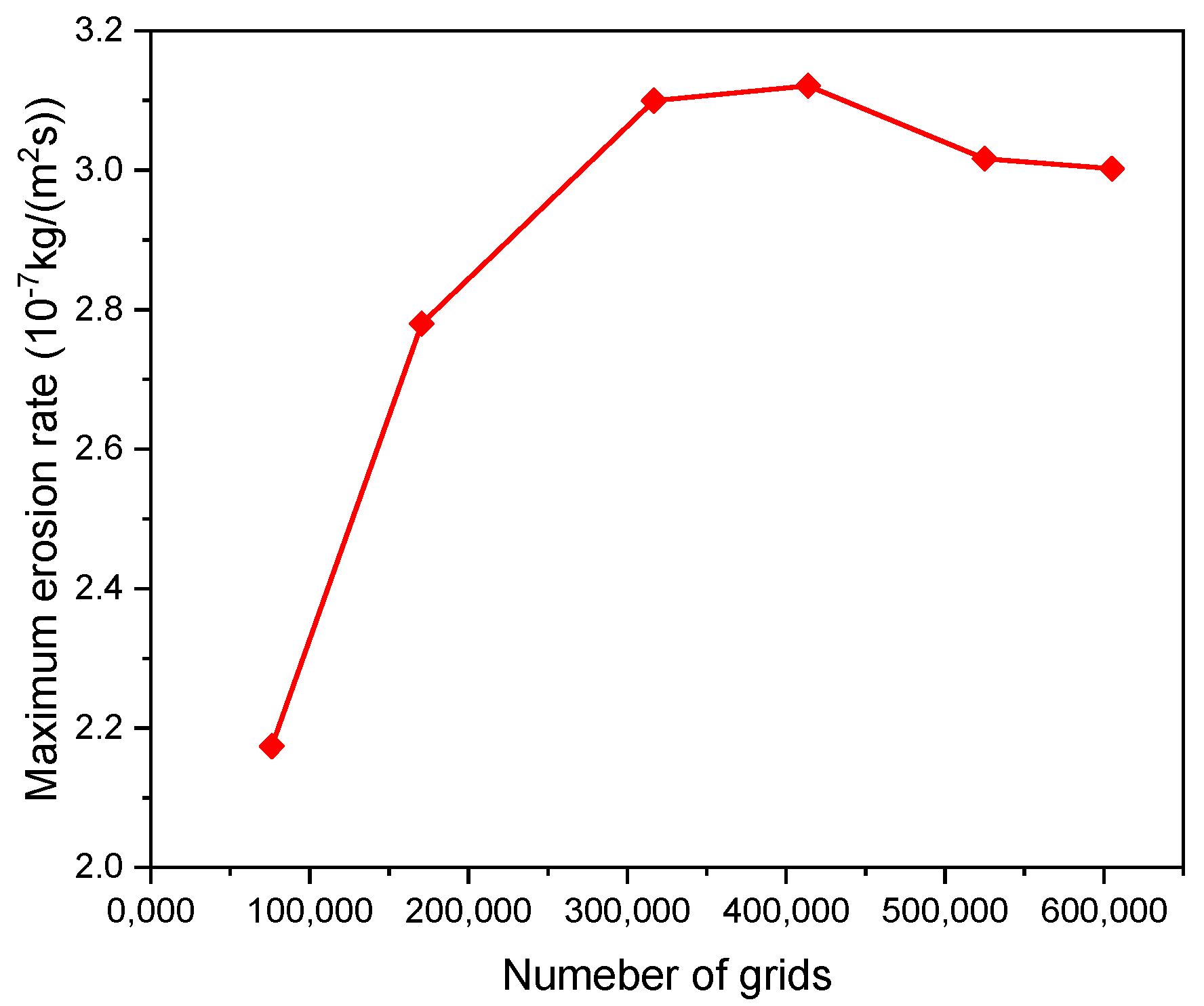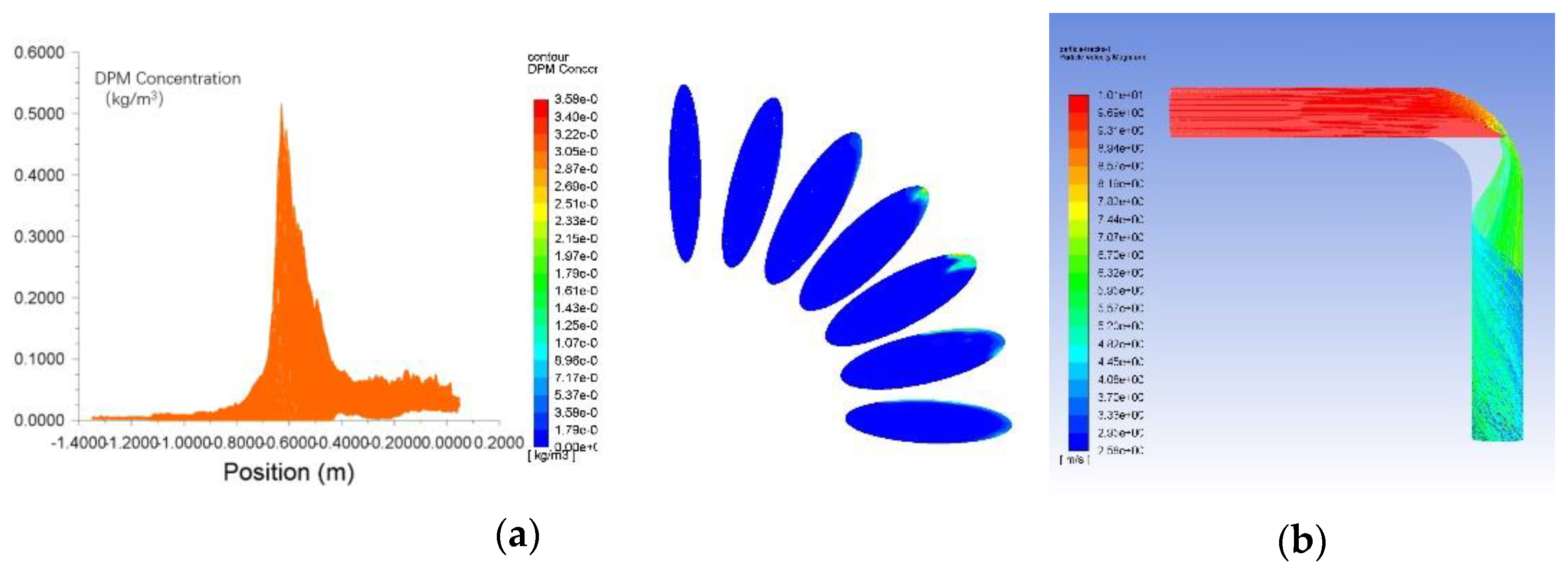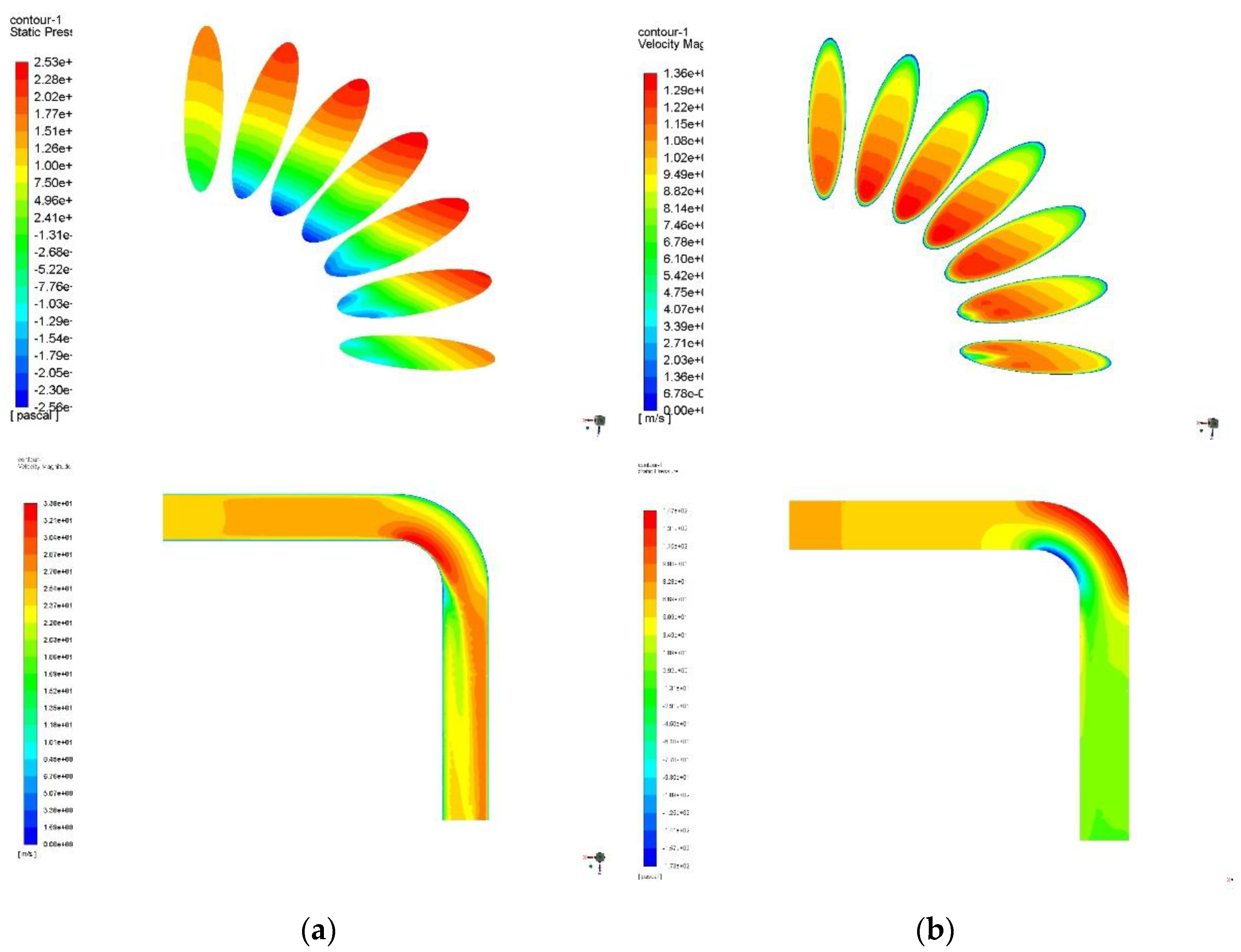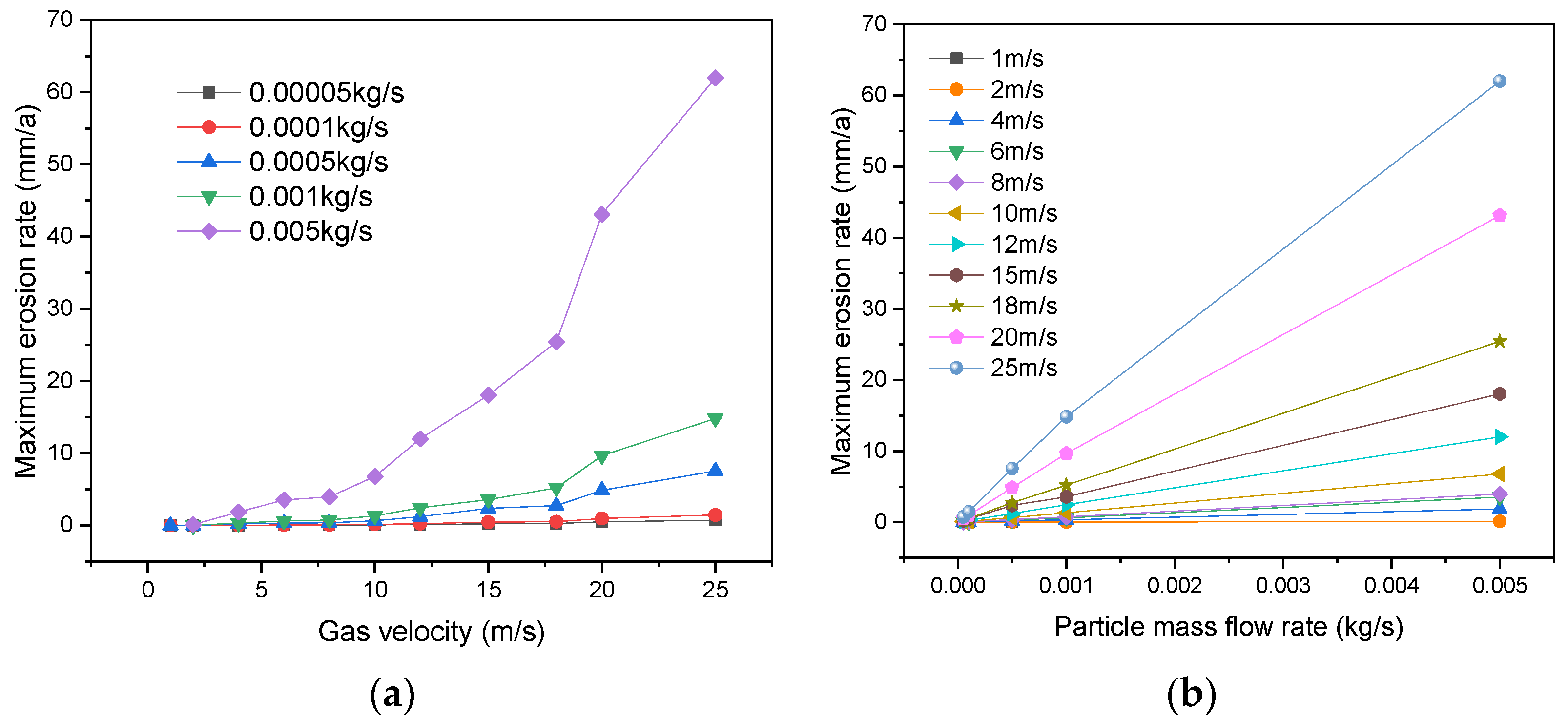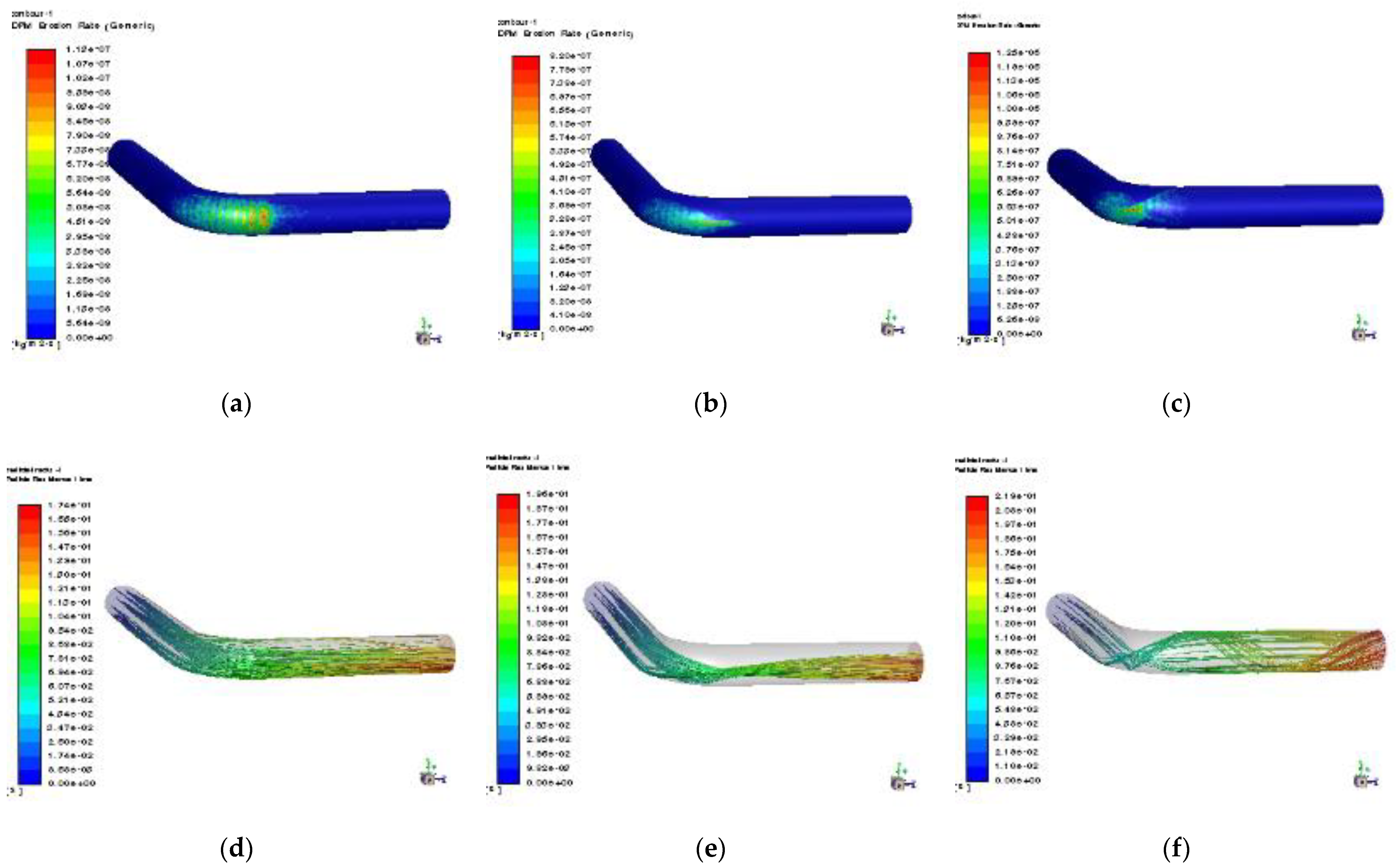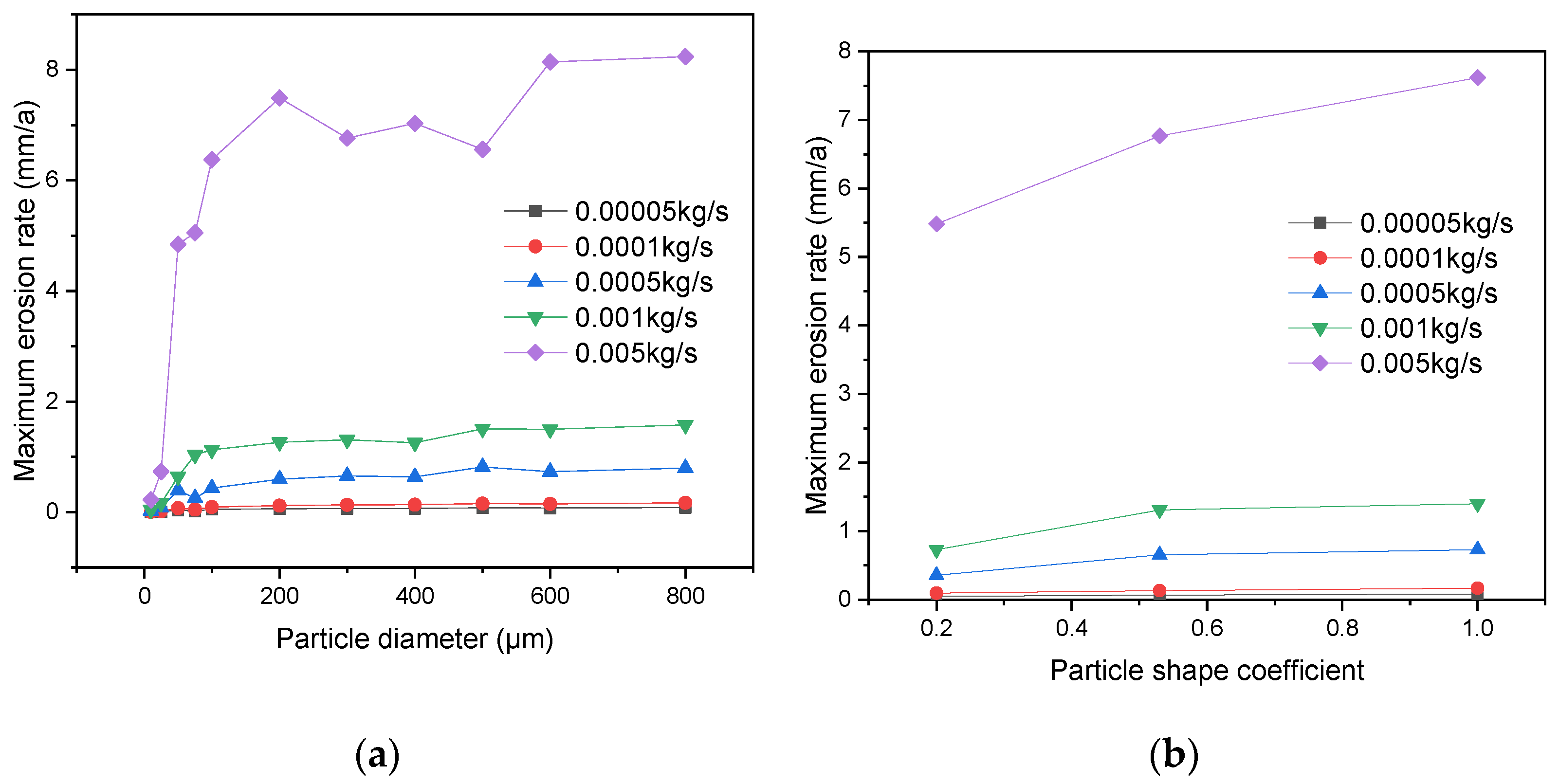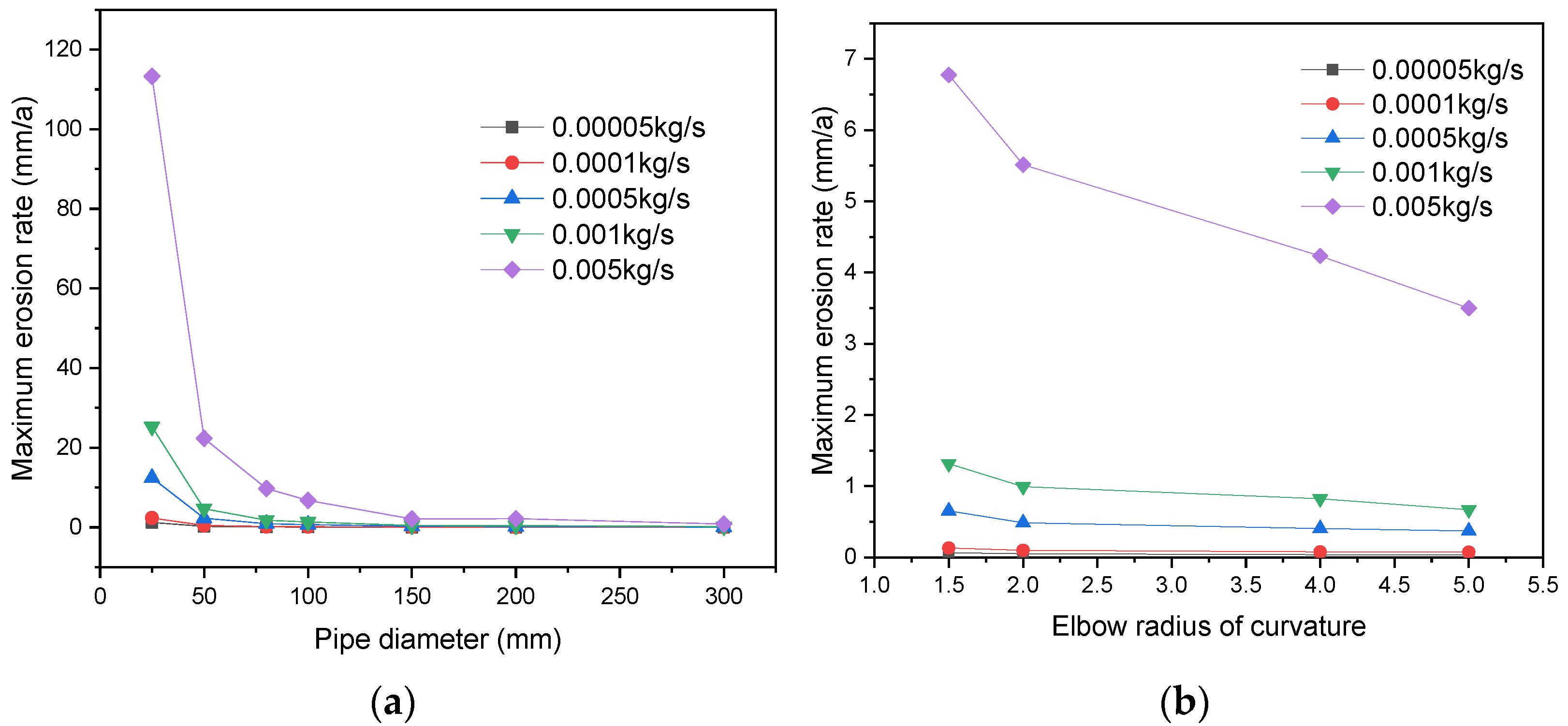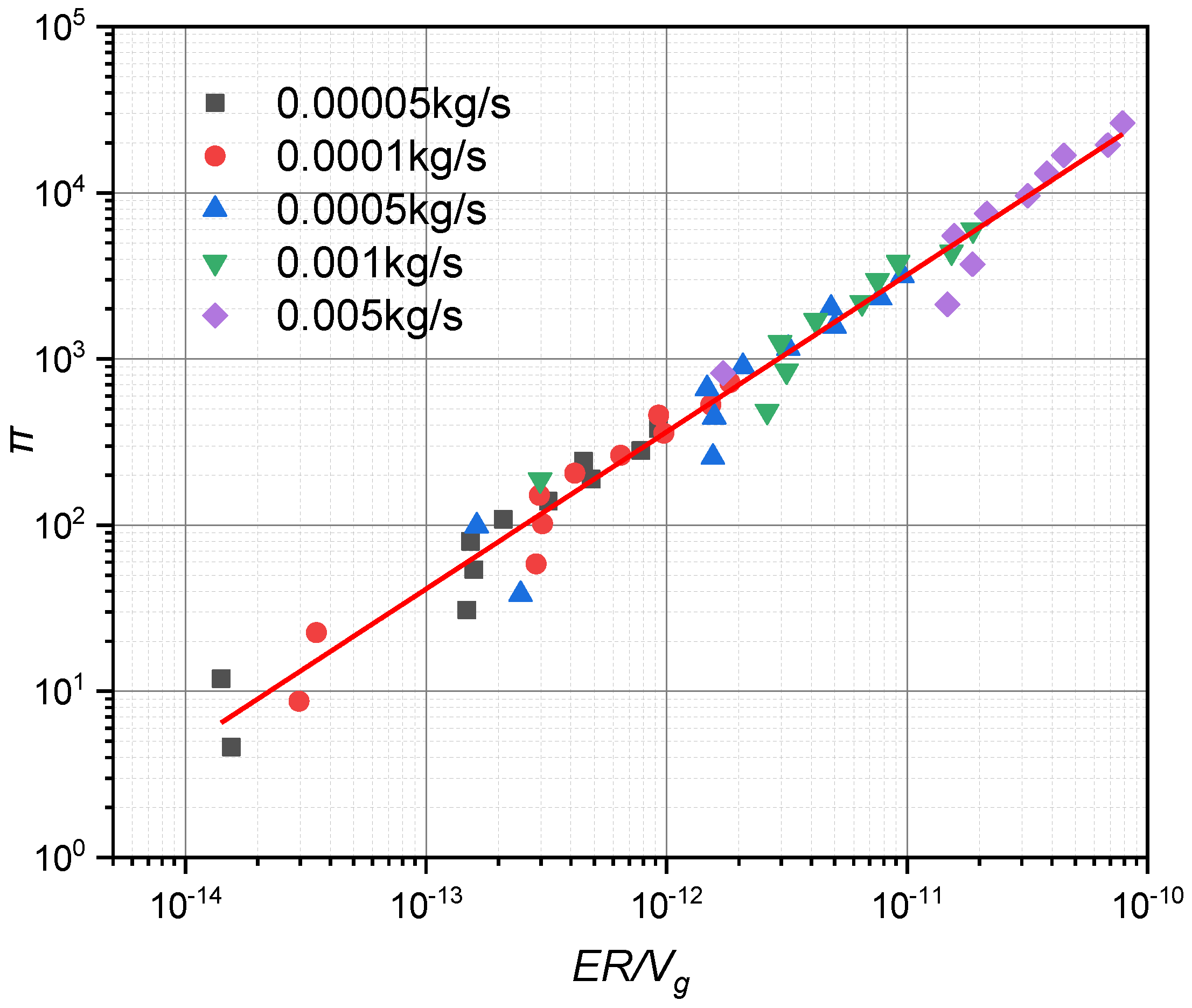1. Introduction
Erosion is a phenomenon of surface damage caused by the impact of fluid bundles or fluid bundles with abrasive solid media on a solid surface [
1]. Due to the presence of solid impurities in the gas component, and the debris caused by pipeline corrosion, there is an inevitably a certain amount of solid particulate matter in any gas transmission pipeline [
2]. Those solid particles are continuously impacting the pipeline wall under the entrainment of the high-speed gas stream, resulting in the erosion of the pipeline [
3]. Therefore, the material of the pipeline wall will be damaged, resulting in the thinning of the pipeline wall, especially at the elbows where the flow direction changes dramatically [
4,
5]. In many cases of pipeline failure, overflow components with sudden changes in flow direction or structure such as bends, elbows, tees, and reducers, are the most prone to local thinning and even perforation [
3,
6]. Eighty percent of the pipeline perforations in gathering pump stations are caused by wear and scour corrosion. The prediction of particle erosion regulation in gas-solid two-phase flow is an effective means to ensure the safe operation of gas transmission pipelines and to prevent equipment failure [
7,
8]. Shale gas fields adopt hydraulic fracturing [
9] and as a result solid particles are often carried in the gas flow, and the pipeline is in a high-pressure state, which is more likely to cause erosion [
3]. Therefore, in-depth analysis of flow field characteristics, considering the motion law of solid particles, predicting erosion rate and erosion distribution, and then being capable to take correct and feasible countermeasures on this basis, are of great significance to the safe operation of shale gas field.
Many scholars are committed to exploring the law of erosion through experimental research [
5,
10,
11,
12]. Leporini et al. [
12] carried out a preliminary experimental study of three phase flows (air-water-sand) inside a horizontal pipe, and the application of the sand-liquid models in the literature was presented. It was concluded that the sand transport characteristics and the critical deposition velocity are strongly dependent on the gas-liquid flow regime and on the sand concentration [
12]. However, the experimental measurements are time-consuming, expensive, and the test equipment usually interferes with the actual flow field. The continuous progress of computer technology leads to the rapid development of computational fluid dynamics (CFD) technology [
4,
13]. Relying on theoretical modeling basis, CFD methods can not only help to understand fluid dynamics problems intuitively and clearly, providing references for experiments and research design, but also greatly save labor, material and time [
6,
14,
15]. Therefore, CFD methods are gradually becoming an important tool for studying flow problems together with experimental fluid dynamics. Based on the CFD method, Peng et al. [
16] proposed an erosion prediction method to investigate the relationships among the gas-liquid distribution, sand movement and erosion profile. The results show that the erosion profiles of the pipeline wall are mainly controlled by three particle collision mechanisms, namely micro-cutting, plowing and impact deformation. Zhu and Qi [
8] employed a CFD-DPM method based on the Eulerian-Lagrangian method and erosion model to study the flow erosion of oil flows containing sand in U-bends. The results show that the erosion mainly occurs on the outer bend, the lower surface of U-bend and downstream pipeline. Zeng et al. [
7] conducted an investigation to study the erosion behavior of elbows with sulfur-containing particles. Based on CFD-DEM model, the erosion prediction model of gas-solid two-phase flow is established considering the interactions of gas-solid, particle-particle and particle-wall. The results show that the V-shaped erosion scar is caused by secondary impact. Wang [
4] established a mathematical model for predicting solid particle erosion in elbow of oil pipeline considering particle fluid interaction. The results show that the erosion mainly occurs near the outlet of elbow, especially at the side wall of downstream straight pipe and the dome of bending section.
In general, erosion under gas-solid two-phase flow is a very complex process and is not yet fully understood. For the gas-solid two-phase flow pipeline widely used in shale gas engineering, it is necessary to simulate the working conditions closer to the actual operating conditions and establish the prediction model of maximum erosion rate. This paper focuses on the numerical simulation of erosion in elbow of shale gas field under gas-solid two-phase flow. By comparing with the experimental data, the reliability of the numerical model is verified, and the erosion wear law under different influencing factors is studied. The research results can provide data reference and theoretical basis for mitigating the erosion rate of pipelines and managing the integrity of gas pipelines.
4. Gas-Solid Erosion Simulation of 90° Elbows
4.1. Parameter Settings
The proposed numerical model above is employed to investigate gas-solid erosion of 90° elbows in shale gas field. The influence of six important factors on the maximum erosion rate are studied. The values of these factors are determined according to the actual production and operation conditions as shown in
Table 2.
According to the settings in
Table 2, the geometric models of pipe with different inner diameters and elbows with different elbow radius of curvature are established, respectively. A straight pipe section with a length of 5D is set before and after the elbow as a flow development section. The inner flow channel is selected as the calculation domain to simulate the gas flow inside the elbow. In order to simulate the boundary layer effect and make the mesh and surface orthogonal, a 3-layer prismatic layer mesh is added to the outer surface of the computational domain. The mesh of the elbow section is encrypted locally, and the mesh is divided as showed in
Figure 5.
Because mesh quality directly affects the accuracy and speed of calculation, in general, the encrypted mesh improves the results accuracy, but it also requires more computer resources. Hence, it is necessary to find a reasonable mesh density. For example, the maximum erosion rate is compared under different mesh quantities for a pipe with an inner diameter of 100 mm and an elbow radius of curvature of 1.5D, as shown in
Figure 6. The number of grids increased from 316,649 to 605,133, and the maximum erosion rate change only 3.1 percent, so the mesh system with a mesh quantity of 316,649 is selected. Besides, mesh independent verification is carried out on other specifications of elbows.
4.2. Result and Disscution
Taking the inner diameter of 100 mm, elbow radius of curvature of 1.5D, gas velocity of 10 m/s, sand mass flow rate of 0.001 kg/s, particle size of 300 μm and shape coefficient of sand of 0.53 as an example to analyze the flow field of the elbow, obtaining the wall erosion distribution, the maximum wall erosion rate, the wall pressure distribution and the particle motion trajectories.
As can be seen from
Figure 7, the erosion is concentrated at the outer wall of the elbow, and the maximum erosion position is about 60° at the outer arc of the elbow. The particle motion trajectories indicate that the particles are approximately moving in a straight line before entering the elbow and the motion trajectory changes when they hit the pipe wall more intensively at the outer arc of the elbow. It can be seen from
Figure 8 that the maximum DPM concentration at the arc of the elbow is the highest, indicating that the particles cluster here. From the contour of DPM concentration, it can be seen that DPM concentration is the highest at the outer arc of the elbow about 40° to 60°. Particle trajectory diagram confirms this finding. The clustering of particles leads to increased erosion rate at the outer wall of the elbow as shown in
Figure 7.
The pressure and the velocity distribution in
Figure 9 show that the pressure rises significantly at the outer arc of the elbow, forming a high-pressure area, while the velocity decreases, and the pressure decreases gradually along the radial direction of the elbow. Numerically, the negative pressure appears at the inner arc of the elbow, where the pressure reaches the minimum value and the flow velocity is the highest. When the sand-carrying gas in the pipeline passes through the elbow, the flow direction of gas changes because of the change of the structure, so the pressure increases at the position of the outer arc surface. At the same time, a large number of particles impact the outer wall of the elbow from different angles, and almost no particles impact the inner wall, thus leading to serious erosion at the outer wall surface of the elbow. The maximum erosion rate of the pipe wall is 3.63 × 10
−7 kg/(m
2·s), where the density of the pipe is 7850 kg/m
3, therefore, the annual maximum erosion depth of the pipe wall is 1.45 mm. The result shows that the sand carrying gas may lead to very serious erosion on the elbow, and moreover causes perforation failure. The following subsections use the controlled variable method on the basis of
Table 2 to study the influence of various factors on erosion.
4.3. Effect of the Gas Velocity
Under the certain conditions of other influencing factors (where the diameter is 100 mm, sand shape coefficient is 0.53, the temperature is 300 K, elbow radius of curvature is 1.5D, sand diameter is 300 μm), the maximum erosion rate and particle motion trajectories at different gas velocity are obtained to study the effect of the gas velocity on the maximum erosion rate.
As can be seen from
Figure 10a, the faster gas velocity is, the greater the maximum erosion rate of the pipe wall will be. On the one hand, as the gas velocity increases, the relative velocity between the sand particles and elbow wall increases as well, and the kinetic energy of the sand particles increases; on the other hand, as the flow velocity increases, the impacting frequency of the sand particles to elbow wall increases, thus causing the more serious erosion of the elbow wall. When the flow rate increases to about 10 m/s, the maximum erosion rate increases more obviously with the increase of gas velocity. Therefore, under this condition, the gas velocity should be controlled not to exceed 10 m/s, so as to slow down the erosion degree of the elbow wall. In addition, the following microscopic flow laws can be obtained through numerical simulation. when the fluid flows slowly, the low velocity makes the sand settle to the bottom of the horizontal elbow, and the gravitational influence on the sand particles dominates, leading to the erosion area of the elbow being concentrated at the bottom of the pipe. When the flow velocity increases, the maximum erosion area gradually moves from the bottom of the elbow to the outer wall of the elbow, and the trajectory of the sand particles becomes more complex.
4.4. Effect of the Sand Mass Flow Rate
Similarly, under the certain conditions of other influencing factors (where the diameter is 100 mm, sand shape coefficient is 0.53, the temperature is 300 K, the elbow radius of curvature is 1.5D, sand diameter is 300 μm), the maximum erosion rate and particle motion trajectories at different sand mass flow rate are obtained to study the effect on the maximum erosion rate.
With the increase of the sand mass flow rate, the movement trajectory of the sand particles is basically the same and the maximum erosion position of the pipe wall is unchanged. However, the maximum erosion rate shows a significant linear upward trend in
Figure 10b, which indicates that the increase of sand content in the pipeline can enhance the erosion wear of the pipe wall. This is because as the mass flow rate of sand particles increases, the number of particles in the pipeline also increases. Therefore, the frequency of particle impact on the wall per unit area increases, resulting in an increase in the erosion rate of the pipe wall.
4.5. Effect of the Particle Diameter
Figure 11 shows the contours of erosion rate and particle movement trajectories under different particle diameters. In the case of a certain sand mass flow rate, the smaller the particle diameter, the greater the number. Therefore, when the particle diameter is small, the erosion area of the elbow is larger, and when the particle diameter is larger, the erosion area of the elbow pipe is more concentrated, and the erosion area is smaller. In addition, the larger the particle size, the more obvious the influence of gravity on the particles, thus the more obvious sinking will occur during the movement.
Figure 12a shows that there is a “critical particle diameter “, which is 100 μm under the working conditions used in this paper. When the diameter of sand is less than the critical particle diameter, the maximum erosion rate increases obviously with the increase of sand diameter, while when it is more than the critical particle diameter, the maximum erosion rate starts fluctuating and changing little, which is determined by the particle diameter and the number of particles.
4.6. Effect of the Particle Shape Coefficient
Figure 12b shows that the maximum erosion rate increases gradually when the shape coefficient of sand particles increases from 0.2 to 1, especially when the sand particle diameter is small, the change becomes more obvious.
4.7. Effect of the Pipe Diameter
Using the controlled variable method, the variation law of the maximum erosion rate with the pipe diameter is obtained, as shown in
Figure 13a. When the pipe diameter is less than 80 mm, as the pipe diameter increases, the maximum erosion rate of the pipe wall decreases rapidly; but when the pipe diameter is greater than 80 mm, the maximum wall erosion rate decreases slowly.
This is because when the pipe diameter is small, the particles in the pipe are more concentrated, and the part that hits the inner wall of the elbow when passing through the elbow is more concentrated. On the contrary, when the pipe diameter is larger, the radial space inside the pipe is larger, the distribution of particles is more dispersed, the particles are obviously affected by gravity, and gradually deposit at the bottom of the pipe, resulting in the offset of the erosion area compared with the smaller pipe diameter. In addition, the probability of solid particles hitting a unit pipe wall area decreases, resulting in a relatively small maximum erosion rate. In addition, the probability of solid particles impacting on the unit wall area decreases, resulting in a relatively small maximum erosion rate.
4.8. Effect of the Elbow Radius of Curvature
The influence of four kinds of the elbow radius of curvature of 1.5D, 2D, 4D and 5D on the maximum erosion rate was studied. It can be seen from
Figure 13b that the maximum erosion rate of the pipe wall decreases with the increase of the elbow radius of curvature, and the decreasing trend is more obvious when the radius is small. This is because the bending path becomes longer with the increase of elbow radius; when the elbow radius is 4D and 5D, the particles impact the wall twice at the elbow, resulting in the erosion area becoming longer; but when the elbow radius is 1.5D and 2D, the particles impact the pipe wall more intensively, so the erosion area is more concentrated.
5. Dimensionless Analysis
Different flow and particle parameters have different effects on the erosion rate. Based on numerical simulation data above, a dimensionless mechanism model describing erosion can be obtained through dimensional analysis, which makes it easier to predict erosion rate and develop the correlation. The dimensionless erosion (
ER/Vg) is a function of the following three dimensionless group [
21]:
where
π1 is the Reynolds number (
Re),
π2 is the ratio of particle diameter (
dp) to the pipe diameter (
D), and
π3 is the ratio of particle density (
ρp) to the gas density (
ρg),
ER and
Vg are the erosion rate and the gas velocity, respectively. Because the erosion rate is related to the number of particles, so the number of particles should be considered and the number of particles (
Np) when the particle mass flow is 0.001 kg/s is used as a reference particle number (
Np_ref). Then, a power-law relationship is employed to combine the three equations above and into the number of particles one group:
where
α, β, γ and
η are undetermined coefficients that can be obtained by data regression. The combined dimensionless group (
π4) is plotted against dimensionless erosion ratio. As shown in
Figure 14, for each specific particle mass flow rate, the corresponding results are in a linear relationship approximately demonstrating that the data points for different conditions are on the same single line.
Therefore, the undetermined coefficients α, β, γ and η are obtained, so dimensionless group (π) is expressed as following:
In addition, based on
Figure 14, the following correlation is established:
Which can also be written as:
From the analysis results, it can be found that erosion in an elbow is proportional to the gas velocity to the power of 2.41, which is close to the value of 2.6 in
Section 2.3. And as the elbow’s diameter increases, erosion rate decreases with the square of the diameter, which is consistent with the results in
Section 4.7.
